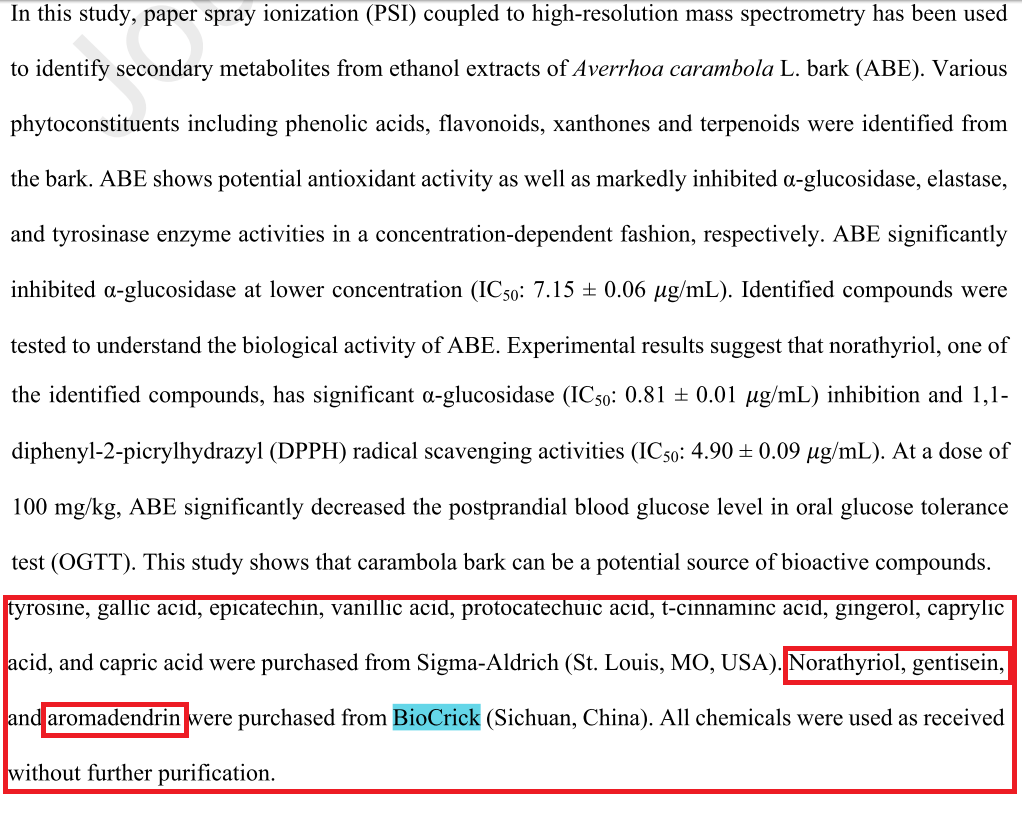Identification of secondary metabolites in Averrhoa carambola L. bark by high-resolution mass spectrometry and evaluation for α-glucosidase, tyrosinase, elastase, and antioxidant potential
Food Chemistry Volume 332, 1 December 2020, 127377
PMID:32619942
 In this study, paper spray ionization (PSI) coupled to high-resolution mass spectrometry has been used to identify secondary metabolites from ethanol extracts of Averrhoa carambola L. bark (ABE). Various phytoconstituents including phenolic acids, flavonoids, xanthones and terpenoids were identified from the bark. ABE shows potential antioxidant activity as well as markedly inhibited α-glucosidase, elastase, and tyrosinase enzyme activities in a concentration-dependent fashion, respectively. ABE significantly inhibited α-glucosidase at lower concentration (IC50: 7.15 ± 0.06 μg/mL). Identified compounds were tested to understand the biological activity of ABE. Experimental results suggest that norathyriol, one of the identified compounds, has significant α-glucosidase (IC50: 0.81 ± 0.01 μg/mL) inhibition and 1,1-diphenyl-2-picrylhydrazyl (DPPH) radical scavenging activities (IC50: 4.90 ± 0.09 μg/mL). At a dose of 100 mg/kg, ABE significantly decreased the postprandial blood glucose level in oral glucose tolerance test (OGTT). This study shows that carambola bark can be a potential source of bioactive compounds.
In this study, paper spray ionization (PSI) coupled to high-resolution mass spectrometry has been used to identify secondary metabolites from ethanol extracts of Averrhoa carambola L. bark (ABE). Various phytoconstituents including phenolic acids, flavonoids, xanthones and terpenoids were identified from the bark. ABE shows potential antioxidant activity as well as markedly inhibited α-glucosidase, elastase, and tyrosinase enzyme activities in a concentration-dependent fashion, respectively. ABE significantly inhibited α-glucosidase at lower concentration (IC50: 7.15 ± 0.06 μg/mL). Identified compounds were tested to understand the biological activity of ABE. Experimental results suggest that norathyriol, one of the identified compounds, has significant α-glucosidase (IC50: 0.81 ± 0.01 μg/mL) inhibition and 1,1-diphenyl-2-picrylhydrazyl (DPPH) radical scavenging activities (IC50: 4.90 ± 0.09 μg/mL). At a dose of 100 mg/kg, ABE significantly decreased the postprandial blood glucose level in oral glucose tolerance test (OGTT). This study shows that carambola bark can be a potential source of bioactive compounds.
- Norathyriol
Catalog No.:BCN5294
CAS No.:3542-72-1
- Gentisein
Catalog No.:BCN3356
CAS No.:529-49-7
- Aromadendrin
Catalog No.:BCN5552
CAS No.:480-20-6


